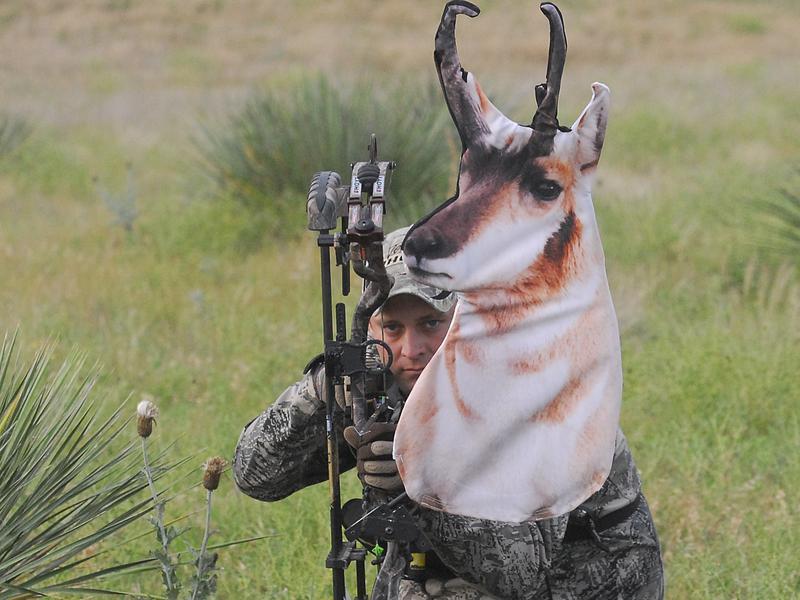Its keen eyesight and reigning title of North America’s fastest land mammal make pronghorns one of the most challenging and exciting critters to bowhunt.
Whether you call them pronghorns, antelope, speed goats, or diaper butts, getting within bow range open prairies is never easy. Let’s review a few tricks that can help.
Most archery pronghorn seasons open in mid-August, often making them the first Western big-game animals bowhunters can pursue each year. Tags are affordable and available over the counter in Colorado, Nebraska and South Dakota, to name a few states. Pronghorn numbers are healthy throughout much of its range, offering bowhunters opportunities to try decoying, spot-and-stalk, or ambushing them from blinds.
Nonresident bowhunters should visit state-agency websites for specific opening dates, license prices and availability, and how to buy one. You can expedite the process by using GoHUNT’s Insider program, which provides a one-stop-shop for learning how to get a tag, find and access public lands, and locate local amenities. Also consider using online mapping applications like OnX Hunt to electronically scout locations, unravel access roads, find camping sites, and mark access points. By using online tools in unison you can compare areas and find hunting sites that are right for you.

Antelope tend to wander around wide open grasslands, but they also frequent badlands. Photo Credit: John Hafner
Whether you prefer spot-and-stalk hunting or waiting them out in a ground blind, it’s important to respect the pronghorn’s incredible eyesight. They detect the slightest movements at long distances. Keep that in mind while e-scouting hunting locations. If you want to burn boot leather and sneak within bow range of your quarry, look for broken terrain and landscape features that give you advantages. Pronghorns often live on open grasslands with little cover, but they’re just as comfortable in the West’s rugged badlands.
Once you’re onsite and hunting, glass the landscape at dawn when pronghorn are moving to bed. Temperatures are usually hot during these early seasons, so pronghorns seek whatever shade is available. Once they bed, start your stalk. Note landmarks that pinpoint the goat’s whereabouts, and mark them on your smartphone so you can keep track of the animal’s last known location.
Meanwhile, monitor the wind to ensure your approach prevents your scent from blowing toward the animals. You’ll likely have to crawl within bow range, so use knee and elbow pads to protect you from thorns and cactus spines. Once you’re within bow range, be patient. Wait for the pronghorn to stand up and offer a shot. If you try to arrow a bedded antelope, you risk spooking or wounding it.
If you’re comfortable setting up and waiting out your quarry, this proven tactic consistently fills pronghorn tags. In years with drought-like conditions, pronghorns seldom move far from a cattle tank or other water.
Narrow your options to a few such sites, and place a trail camera at each spot to identify patterns. Then, set up a pop-up blind and wait. This tactic might not sound physically exhausting, but ground blinds baking beneath an August sun feel like a dry sauna. Pack accordingly and bring plenty of water. It might take many long days in the blind to pay off, but patient endurance can prevail.

Pronghorn’s are very responsive to decoys. Photo Credit: Head’s Up Decoy
Pronghorns rely heavily on their vision, so they’re susceptible to decoys. Mobile, two-dimensional decoys like the Heads Up system are lightweight and even mount to your bow. Lightweight decoys earn their space in your backpack whether you set out to decoy a pronghorn, or you prefer spot-and-stalk hunts. Decoying works best in September when pronghorns rut.
The pronghorn’s unique two-toned hair forms a 90-degree angle at the shoulder blade. Aim just low of the lateral line and inside the vertical line behind the shoulder. That will put your arrow through the pronghorn’s vitals. Most bowhunters practice shooting 60 yards and beyond. The West’s open landscapes can make it difficult to sneak into top-pin range, so strive for proficiency farther than you would typically shoot at Midwestern whitetails.
Pronghorns make delicious table fare, so act quickly when processing your animal in these hot conditions. Cool the meat soon after recovering the animal; first gutting and then skinning it. If you’re quartering the pronghorn and packing it out, keep the meat free of hair and slide it into a clean game bag. Keep the meat out of direct sunlight, and store it inside a cooler beneath ice as quickly as possible. Timely care ensures you’ll enjoy delicious pronghorn meat long after returning home.
Whether you’re making your first Western bowhunt or simply targeting a new species, never overlook the pronghorn. They’re fun and challenging to bowhunt, and fairly accessible to all. Don’t wait. Start planning now to ensure your bowhunting skills can take on this iconic Western species.